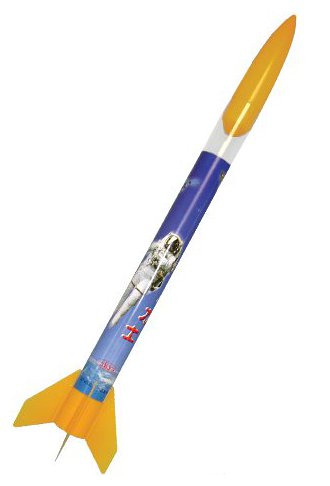| Construction Rating: | starstarstarstar_borderstar_border |
| Flight Rating: | starstarstar_borderstar_borderstar_border |
| Overall Rating: | starstarstar_borderstar_borderstar_border |
| Published: | 2012-07-26 |
| Diameter: | 1.38 inches |
| Manufacturer: | Sky  |
| Skill Level: | 1 |
| Style: | Payload |
 Brief
Brief
This is a model from Sky and it would be comparable to an E2X kit from Estes, a pretty simple design that can be put together in a few minutes and fly as soon as the glue is dry.
Components
The rocket comes with a soft plastic nose cone and a clear payload. Unlike most payload kits, the payload is not a tube that has a separate cap at the end, but rather it is one single piece of preformed plastic. The fin can has four slots and the plastic fins slide in, glued in place with model cement. The shock cord was a thin piece of elastic rather than a rubber band. However, the engine hook was about half as wide as I would expect.
Construction
The parts fit well together. I had no issues except for one fin that took quite a bit of effort to get into the slot. The fins felt rather brittle, so I was afraid I might snap one off. The rocket feels heavy for its size.
Finishing
The body tube is wrapped in random space photos: a Voyager picture of Saturn, Skylab, a Shuttle astronaut, etc. At least it doesn't have to be painted. The fins and nosecone were a light orange color and would probably be very visible in the sky.
Flight
Considering the rocket is pretty big around, the payload is actually not very large. The nosecone sits in place, taking up most of the space. I couldn't fit an MD-80 video camera in there and the Altimeter Two barely fit. The motor slid in fine and the engine hook seemed to hold it in place, despite how flimsy it seemed. One odd thing was the nosecone fit very tightly into the payload section. So tight, in fact, the air pressure kept pushing the nose cone back out. I had to push it in several times before enough air managed to squeeze out the sides to allow the nosecone to stay in place. To be sure, I taped it to the payload section.
Recovery
The kit came with a thin plastic parachute, which I substituted for a nylon parachute. The rocket was a lot heavier than similar kits. We launched it on an Estes A-8-3 and it went up exactly 28 feet. Our similarly sized Patriarch would fly about four times that height on an A. There was no visible damage. However, when I pulled the engine out, the entire engine mount came out as well.
Summary
I was hoping for a little more from the kit. The clear palyoad appealed to me to use with a camera, but it turned out to be so small as to be almost useless. The body tube is slightly larger than a similar body tube on Estes rockets. For example, I was going to use the payload and nosecone on a similarly sized Estes model, but it was just a hair too big. I'm a little concerned about that if I have to try and jerry-rig repair parts for the engine mount. The design was a little random, though it did remind me of some Japanese candy boxes I've seen in the past. If we get it fixed, my guess is it will require a C motor and - even then - it will probably be an underperformer. It would probably be a good kit for younger kids and folks who have a small area to launch from.
 |
 |
Flights
 |
 |